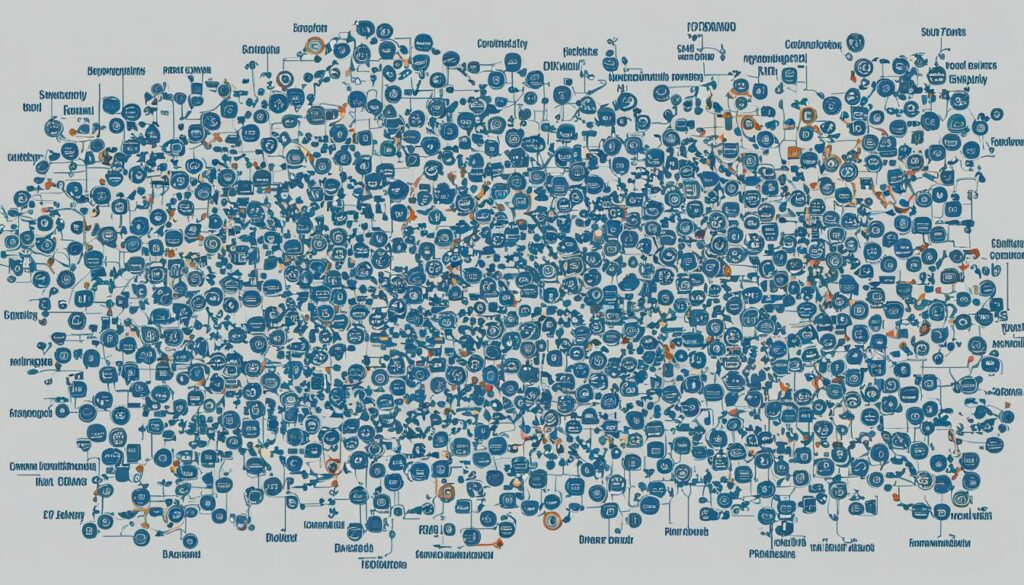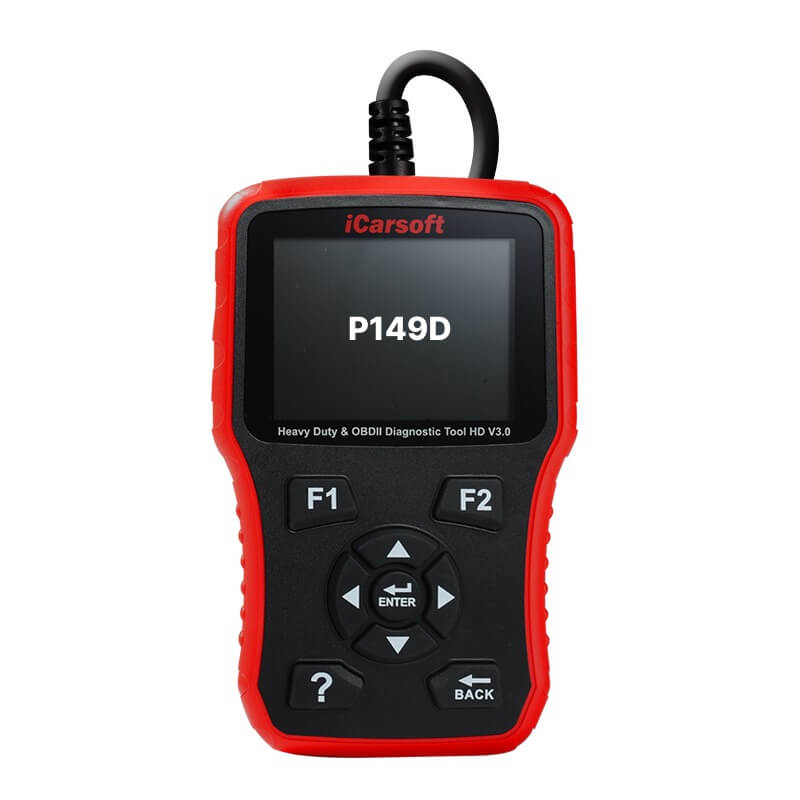P149D – DPF 2 Control Performance
POSTED IN pcodes
Welcome to our article on P149D – DPF 2 Control Performance. In this guide, we will explore the causes, symptoms, and troubleshooting steps related to this engine fault code. Understanding and addressing this issue is crucial for maintaining optimal engine performance and ensuring the proper functioning of your vehicle’s emission control system.
The P149D code specifically relates to a control performance problem with the DPF (diesel particulate filter). The DPF plays a vital role in reducing harmful emissions from the exhaust system. When this code is present, it can impact engine performance and lead to potential complications if left unaddressed.
Key Takeaways:
- P149D is an engine fault code related to control performance of the DPF (diesel particulate filter).
- It can affect engine performance and the proper functioning of the vehicle’s emission control system.
- Common causes include a faulty DPF, issues with the exhaust system, and engine fault codes.
- Troubleshooting steps involve diagnostic testing, DPF cleaning, and potential repair or replacement of components.
- Regular vehicle maintenance, including DPF cleaning and inspections, is crucial for preventing this code.
Understanding P149D – Symptoms and Impact
When the P149D code is present, it can have various symptoms and significantly impact both the engine performance and the emission control system of the vehicle.
The symptoms associated with the P149D code include:
- An illuminated check engine light, indicating a potential issue with the engine’s performance.
- Continuous running of the cooling fans, which can indicate excessive heat buildup in the engine.
- Potential issues with the catalytic converter, which is an essential component of the emission control system.
Addressing the P149D code promptly is crucial to prevent further damage to the engine and ensure compliance with emission regulations.
Buy tested tuning file for Adblue / EGR / DPF / Adblue off now!
“The P149D code can have significant ramifications for both the engine performance and the emission control system. It is important to take immediate action to rectify the issue and prevent any potential long-term damage to the vehicle.”
Proper diagnosis and resolution of the P149D code can restore the engine’s performance and uphold the vehicle’s adherence to environmental standards. The impact of the code on engine performance can be mitigated by addressing the underlying cause and resolving any issues related to the diesel particulate filter (DPF) and the emission control system.
| Symptoms | Impact |
|---|---|
| An illuminated check engine light | Indicates potential engine performance issues |
| Continuous running of cooling fans | Signifies excessive heat buildup in the engine |
| Potential issues with the catalytic converter | Affects the functionality of the emission control system |
Common Causes of P149D
Understanding the common causes of the P149D code can help diagnose and address the issue effectively. Several factors can trigger this code, including problems with the diesel particulate filter (DPF), exhaust system issues, and engine fault codes.
DPF Issues
- A clogged or malfunctioning DPF can lead to the P149D code. Over time, the DPF can become filled with soot and other particles, restricting exhaust flow and causing performance issues.
- Insufficient regeneration of the DPF can also contribute to the P149D code. If the regeneration process is not occurring properly, soot accumulation can occur, affecting the filter’s efficiency and triggering fault codes.
Exhaust System Problems
- Leaking or damaged components in the exhaust system, such as pipes, gaskets, or sensors, can result in inadequate pressure or incorrect readings, leading to the P149D code.
- Exhaust leaks before or after the DPF can impact the system’s ability to regulate emissions properly and trigger fault codes, including P149D.
Engine Fault Codes
- Engine fault codes related to the emission control system can activate the P149D code. These fault codes are typically detected through diagnostic testing and can indicate underlying issues that need to be addressed.
- Other engine-related issues or malfunctions, such as fuel delivery problems or sensor failures, can indirectly contribute to the P149D code.
Diagnostic testing is essential to pinpoint the exact cause of the P149D code. Using specialized scanning tools and equipment, technicians can identify specific fault codes and system abnormalities, helping guide the necessary repairs.
Addressing the common causes of the P149D code promptly can help maintain optimal engine performance, ensure compliance with emission regulations, and prevent further damage to the vehicle’s exhaust system.

Troubleshooting Steps for P149D
When encountering the P149D code related to DPF 2 Control Performance, it is important to follow a series of troubleshooting steps to identify and resolve the issue. By conducting comprehensive engine diagnostics, checking the status of the diesel particulate filter (DPF), and performing necessary repairs or cleaning, you can effectively address the problem and restore proper engine performance and emission control. Here are the key steps to take when troubleshooting the P149D code:
- 1. Conduct Engine Diagnostics: Begin by using an engine diagnostic tool to scan for any additional fault codes that may be present. This will help identify any related issues that could be contributing to the P149D code.
- 2. Check DPF Status: Inspect the condition of the diesel particulate filter (DPF) to determine if it is clogged or malfunctioning. This can be done by visually examining the filter or using specialized DPF diagnostic equipment.
- 3. Clean the DPF: If the DPF is found to be clogged with soot or other contaminants, a thorough cleaning may be necessary. This can be done through various methods, such as DPF regeneration or manual cleaning.
- 4. Repair or Replace Components: If the DPF or any other components of the emission control system are found to be faulty, they may need repair or replacement. Consult with a qualified mechanic or technician to determine the best course of action.
By following these troubleshooting steps, you can address the P149D code and ensure the proper functioning of the emission control system. Taking prompt action will help maintain engine performance, prevent further damage, and ensure compliance with emissions regulations.
Professional Assistance for P149D
In cases where professional assistance is needed for addressing the P149D code, it is recommended to seek the help of a qualified technician or mechanic. However, when professional assistance is unavailable or not desired, there may be an alternative solution.
Some service providers offer the permanent removal of the P149D code by uploading the Engine Control Unit (ECU) file to their portal. This option should only be considered after careful consideration and consultation with experts.
Importance of Regular Vehicle Maintenance
Regular vehicle maintenance is essential in preventing issues like the P149D code and ensuring the optimal performance of your vehicle’s engine and emission control system. By prioritizing vehicle maintenance, you can avoid costly repairs and maintain a smooth and efficient driving experience.
Prevention of P149D Code
One of the key benefits of regular vehicle maintenance is the prevention of issues like the P149D code. By scheduling routine inspections and servicing, you can identify and address potential problems in the early stages. This proactive approach allows you to mitigate the risk of code-related issues such as DPF (diesel particulate filter) failure or control performance malfunctions.
Emission Control System Maintenance
Regular maintenance involves inspecting and maintaining the various components of the emission control system. This includes checking the condition of the DPF, ensuring it is clean and free from clogs or blockages. If necessary, performing DPF cleaning as recommended by the manufacturer can help maintain the effectiveness of the emission control system and reduce the likelihood of codes like P149D.
Additionally, regular maintenance can help identify other potential issues that may affect the emission control system, such as leaks in the exhaust system or faulty sensors. By detecting and addressing these issues early on, you can prevent them from escalating and causing further damage to the system.
Optimal Engine Performance
Regular maintenance not only ensures the smooth functioning of the emission control system but also contributes to overall engine performance. By keeping the engine properly maintained, you can improve fuel efficiency, reduce emissions, and extend the longevity of essential engine components.
Expert Tips and Recommendations
“To maintain the performance and longevity of your vehicle, it is important to follow the manufacturer’s recommended maintenance schedule. This will ensure that all necessary inspections, fluid changes, and component replacements are carried out at the appropriate intervals.”
Additionally, consulting a certified technician or mechanic for professional advice and assistance can help you make informed decisions about vehicle maintenance. They can provide specific recommendations based on your vehicle’s make, model, and mileage, guiding you on the optimal maintenance practices to prevent codes like P149D and promote the longevity and performance of your vehicle.
Remember, investing time and effort into regular vehicle maintenance not only saves you money in the long run but also contributes to a safer and more enjoyable driving experience.
The Meaning and Severity of the P149D Code
The P149D code indicates a control performance issue with the DPF 2 (diesel particulate filter). While the exact meaning may vary depending on the vehicle make and model, it generally refers to a malfunction or failure in the emission control system.
This code can have varying degrees of severity, ranging from minor issues that affect engine performance to more serious problems that can lead to engine damage if left unaddressed.
It is important to have the P149D code diagnosed and repaired promptly to prevent further complications. Ignoring the code can result in decreased engine performance, increased emissions, and potential damage to other components of the emission control system.
To fully understand the impact of the P149D code, it is necessary to assess the specific symptoms and perform thorough diagnostics to determine the underlying cause. This will enable technicians to take appropriate measures to resolve the issue and restore the vehicle’s emission control system and engine performance.

Effects of Ignoring the P149D Code
If left unaddressed, the P149D code can lead to more severe consequences:
The engine may experience reduced power and overall performance, causing a decrease in fuel efficiency and an increased risk of engine damage.
The emission control system may not properly regulate harmful emissions, leading to increased pollution and potential non-compliance with environmental regulations.
Addressing the P149D code promptly not only helps maintain optimal engine performance but also ensures the vehicle’s compliance with emission standards, contributing to a cleaner environment.
Severity Chart for the P149D Code
| Severity Level | Description |
|---|---|
| Low | The code has minimal impact on engine performance and emissions. It can be resolved without extensive repairs and may not require immediate attention. |
| Medium | The code indicates a moderate issue that can affect engine performance and emissions. Timely repairs and diagnostics are necessary to prevent further problems. |
| High | The code signifies a severe problem that significantly impacts engine performance, emissions, and overall vehicle functionality. Urgent repairs and professional assistance are essential to prevent further damage. |
Understanding the severity level of the P149D code helps vehicle owners and technicians evaluate the urgency and prioritize repairs accordingly.
Conclusion
The P149D code related to DPF 2 Control Performance is a serious issue that requires immediate attention. Troubleshooting steps should be taken promptly to identify and address the underlying cause of the code. If you are unsure about performing the troubleshooting yourself, it is advisable to consult a qualified technician or mechanic for professional assistance.
Regular vehicle maintenance is essential for preventing the occurrence of the P149D code. It is highly recommended to schedule routine inspections and maintenance, including regular DPF cleaning, as recommended by your vehicle’s manufacturer. By prioritizing vehicle maintenance, you can help ensure the proper functioning of the emission control system and maintain optimal engine performance.
To summarize, addressing the P149D code related to DPF 2 Control Performance requires troubleshooting to diagnose and resolve the root cause. If needed, seeking professional assistance from a qualified technician or mechanic is crucial. Additionally, regular vehicle maintenance, including inspections and DPF cleaning, plays a vital role in preventing the occurrence of this code and maintaining the overall health of your vehicle’s emission control system.
FAQ
What does the P149D code mean?
The P149D code refers to a control performance issue with the DPF (diesel particulate filter) in the vehicle’s emission control system, which can affect engine performance.
What are the symptoms and impact of the P149D code?
Symptoms may include an illuminated check engine light, continuous running of the cooling fans, and potential issues with the catalytic converter. The code can have an impact on the vehicle’s engine performance and emission control system.
What are the common causes of the P149D code?
Common causes include a faulty DPF, issues with the exhaust system, and engine fault codes related to the emission control system.
What are the troubleshooting steps for the P149D code?
Troubleshooting steps may involve conducting engine diagnostics to identify other fault codes and checking the status of the DPF. Cleaning, repair, or replacement of the DPF or other components may be necessary.
Do I need professional assistance for the P149D code?
It is recommended to seek the help of a qualified technician or mechanic for addressing the P149D code. However, some service providers offer alternative solutions, such as the permanent removal of the code through the upload of the Engine Control Unit (ECU) file to their portal.
How important is regular vehicle maintenance in preventing the P149D code?
Regular vehicle maintenance, including inspections and DPF cleaning as recommended by the manufacturer, is crucial for preventing issues like the P149D code. It helps ensure proper functioning of the emission control system and engine performance.
What is the meaning and severity of the P149D code?
The P149D code indicates a control performance issue with the DPF and can range in severity from minor issues affecting engine performance to more serious problems that can lead to engine damage if left unaddressed.
Can you provide a conclusion on the P149D code?
The P149D code requires troubleshooting steps to identify and address the underlying cause. Professional assistance from a qualified technician or mechanic is recommended. Regular vehicle maintenance is essential for preventing this code and maintaining the proper functioning of the emission control system and engine performance.


